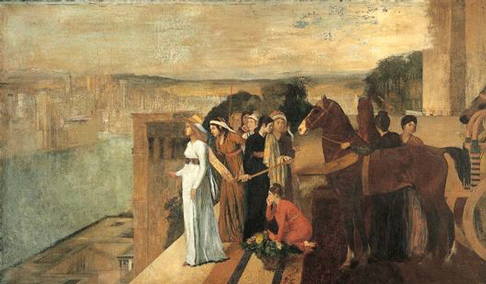09 Aug 2009
Semiramide at Caramoor
You need three or, ideally, four top-flight bel canto specialists to do anything like justice to Rossini’s Semiramide, his last and grandest Italian score. Otherwise why go to the expense?

You need three or, ideally, four top-flight bel canto specialists to do anything like justice to Rossini’s Semiramide, his last and grandest Italian score. Otherwise why go to the expense?
These folks must warble to make all the racket worthwhile. The doubt about the proper number involves the tenor, whose runs, divisions, ornaments, floating lines are equal in difficulty to those of the soprano, the mezzo and the bass, but who is incidental to the plot — remember the plot? As the opera contains nearly four hours of music, it is rare to hear it unsnipped, and the tenor part — two major double arias — is where most producers start snipping.
Semiramide is an opera with everything: spectacular solos, awesome duets, intense ensembles, earthquakes, prophecies, ghosts, incest, insanity, coronations, murder in the dark — well, almost everything: In deference to Mesopotamian weather patterns, this is the rare Rossini opera without a thunderstorm. At Caramoor we very nearly got one anyway — it was a dark and stormy day. At intermission, I had to warn people to turn off their frogs. Frogs can’t resist a cabaletta — in the right throat, cabalettas sound like mating cries.
Sutherland and Horne used to make rather a vehicle-à-deux of this piece — the fraught Semiramide-Arsace relationship is the center of the drama — but the basso villain, Assur, who sings big duets with each of them as well as a coloratura mad scene, should be able to rattle away on their level. Sadly, Samuel Ramey, the first bass in modern times up to Sutherland-Horne bel canto speed, did not assume the role until after Sutherland had renounced it, but he made a memorable antagonist for Caballé and Anderson, when they were singing the title role, and Arsace belonged to Horne well into the ’90s. Today, Rossini technique is more widely studied — have the new crop of singers the chops, the musicality, the endurance to bring this exotic piece to life? The man who would know, methinks, is Will Crutchfield, and last week he led a very grand concert performance of damn near the whole score in Philip Gossett’s critical edition, in the Venetian theater at the Caramoor Summer Festival some forty miles north of New York.
The Semiramis legend, alas, has faded from the popular consciousness, perhaps because Gina Lollabrigida (who had the ideal maternal quality) never made a major Technicolor picture of it. In Rome’s Capitoline Museum, generally ignored in a long gallery of late Renaissance bric-a-brac, hang seven tapestries depicting the queen’s life and career. We see her, a foundling of unknown (perhaps divine) birth, nursed by doves; noticed (while leading an attack on Bactra) by King Ninus, eponym of Nineveh, who falls in love at first sight; sacrificing to Baal upon her husband’s death and her succession to his contested throne; building the Walls of Babylon; leading her armies to conquer Abyssinia or India; hunting tigers in the Pamirs (or wherever); and at last, her power broken by the appearance of her long-lost son, Ninias, the true heir, taking flight with the doves and vanishing among the clouds. It’s a glorious load of gilt-edged bushwah (the real Samu-ramat was simply queen regent of Assyria for a few years), and it’s a pity her story is forgotten, when once she held her own with such semi-mythical exotics as the Queen of Sheba, Cleopatra, King Arthur, Agamemnon and Roland.
 Semiramis Receiving Word of the Revolt of Babylon
1624 by Guercino (Giovanni Francesco Barbieri, 1591-1666) [Museum of Fine Arts, Boston]
Semiramis Receiving Word of the Revolt of Babylon
1624 by Guercino (Giovanni Francesco Barbieri, 1591-1666) [Museum of Fine Arts, Boston]
Voltaire, whose tragedies are only remembered now, if at all, as opera libretti, wrote his Semiramis, Rossini’s source, on themes purloined from Clytemnestra and Orestes: The queen has usurped the throne of her poisoned husband. After a successful reign, she yields to popular demand for a new king, choosing Arsace, a Scythian warrior far her junior — and offering him her hand. Before the misalliance can take place, the ghost of vengeful King Ninus interferes. It turns out Arsace is the long-lost Ninias, Semiramis’s son — and that Ninus was murdered by his wife and her then lover, Assur, prince and claimant to the throne. Complicating matters slightly, Assur, Arsace and an intrusive Indian prince named Idreno (that damned tenor) are all in love with Azema, a princess with surprisingly little to sing. Arsace lunges for Assur in the dark, kills Semiramis instead, and in this horrified state of mind is hailed by an exultant chorus as the king of Babylon. Irony intended. (Running time, uncut: roughly four hours.)
Semiramide calls for a dramatic soprano of range and power as well as endless breath control and virtuoso singing — stars like Patti and Melba long kept the piece alive, but even they worked it best when there was a spectacular mezzo as Arsace — a trouser role — to match them. Assur is a coloratura bass, Idreno a coloratura tenor, and the High Priest, Oroë, too, has some choice warbling to do in ensembles. The chorus parts are by no means negligible — Crutchfield’s forces were small but elegantly persuasive — and the orchestra is, for Italy in 1823, sizable and virtuosic. The overture is the best-known piece in the score, Rossini’s most elaborate treatment of themes from an opera as prelude and character portrait to date, only surpassed six years later in his last opera, William Tell. On the present occasion, heavy humidity did not some damage to timbre, the drums often out of balance or tune, the lyrical explosions of horn, bassoon, clarinet in generally decent form.
But you want to know about the singing of the four stars, don’t you? In fact, that’s the only thing you want to hear about, eh? Okay, here’s the report: Sutherland, Horne and Ramey they weren’t. But today they don’t need to be to put the opera over, and there were long stretches of delirious, generally excellent vocalism. They were cool at their work, and even showed signs of knowing what characters and situations they were playing. Everyone knew what Rossini was about, and was eager to show off what they knew. A lot of why we come to bel canto is to hear people show off, and they had all assimilated that. The only thing I seriously missed in the barrage of rapid-fire passagework from all hands was a genuine musical trill — there was no such thing all night, from anyone, which disappointed those who learned this score from the Sutherland-Horne recordings. Bel canto singers used to focus on their trills; perhaps they no longer bother.
 Semiramide costruisce Babilonia by Edgar Degas [Museo d'Orsay]
Semiramide costruisce Babilonia by Edgar Degas [Museo d'Orsay]
Angela Meade is a young so-called dramatic coloratura — perhaps too young for some of the roles she is rushing into. At her Met debut — just last year — a last-minute substitution in Ernani, she seemed talented but mostly prudent, not risking anything in the first act or two in the way of volume or involvement so that she could be sure of having both for the concluding trio that pricked up the ears. It was a good substitution but not what an Elvira ought to be.
As the scheduled diva, in a major role like Semiramide, she still had problems warming to the task, the voice almost inaudible for the two quartets and uneven in her sortita, the famous “Bel raggio lusinghier”: sometimes a clear, lustrous phrase, sometimes a muddy one. The first duet, “Serbami ognor,” was also cautious, but by the time of the great Coronation-Apparition Scene where Semiramis must be seen — and heard — to command the court, the populace, the entire natural world — so that her terror when the ghost shows up is all the more striking — she was fully in charge, tossing phrases of good size and cool beauty through the crowd. Her duets in Act II were also lovely, very well supported. There were moments of sheer vocal gelato when Meade was singing circular arpeggios — up and then down and then up again — while Vivica Genaux harmonized with perfectly judged triplets against each of Meade’s swift, beautiful notes. It is easy to see why bel canto lovers like Crutchfield adore Meade’s voice, but she will have to work on getting into gear sooner and staying there. She may or may not have a major talent, but she is certainly not ready for the big roles.
Genaux, looking awfully pretty and not the least bit masculine, gave, as Arsace, the most finished performance of the evening, sounding remarkably like Marilyn Horne — not because she sang Horne’s music or in a similar style, but because of a striking similarity of timbre. If anything, Genaux has a richer, less reedy texture to her instrument. Those sitting close might be distracted by the wobbles of her lips during passagework (this may be problematic on video performances), but no one hearing the spectacular effects this habit gives rise to will have any objection to it. She was accomplished, smooth, elegant, indefatigable, warmly in character: the evening’s star — though some regretted the absence of masculine grit in the Horne or Podles manner.
Daniel Mobbs, the wicked Assur, displayed the least impressive instrument of the quartet, a voice without attractive colors, dry and, in the lower reaches, sometimes flat. The expansive threat that Ramey used to bring to the role was not here, nor the stage-grabbing hamminess appropriate to the mad scene. He is an able singer with impressive ease in passagework, but not a producer of fireworks; the adversarial duets lacked thrill.
Lawrence Brownlee had the thankless role of Idreno — but thankless it wasn’t on this occasion, as his arias were met with joy. Brownlee has rapidly become a favorite with American bel canto audiences, our homegrown lirico to set against Florez and Banks, and he tossed his smallish, pretty, plangent voice with total security up and down a very broad range (and very quickly, too), occasionally rising to some sizable and solid high notes where the other stars tended to duck them — probably because they are a modern stylistic whim. Brownlee also acted stern and displeased — suiting Idreno’s role of odd man out — which can’t have been easy considering the audience reaction he was getting.
Despite the rain and the trip and the frogs and the heat, this was a performance to remind us all what fun Semiramide can be, and should be, in the proper hands — and throats. Ending just before midnight, the end didn’t come too soon — but I think most of us were sorry it was a one-shot, that we could not go back later in the week to compare another such performance.
John Yohalem